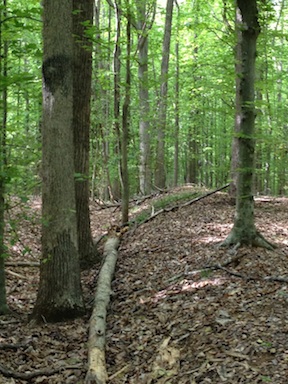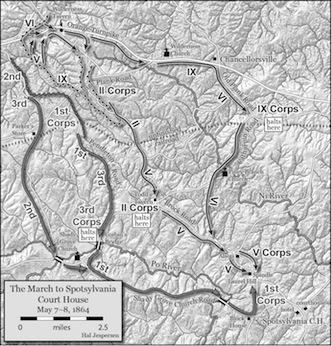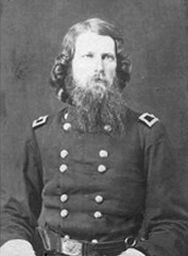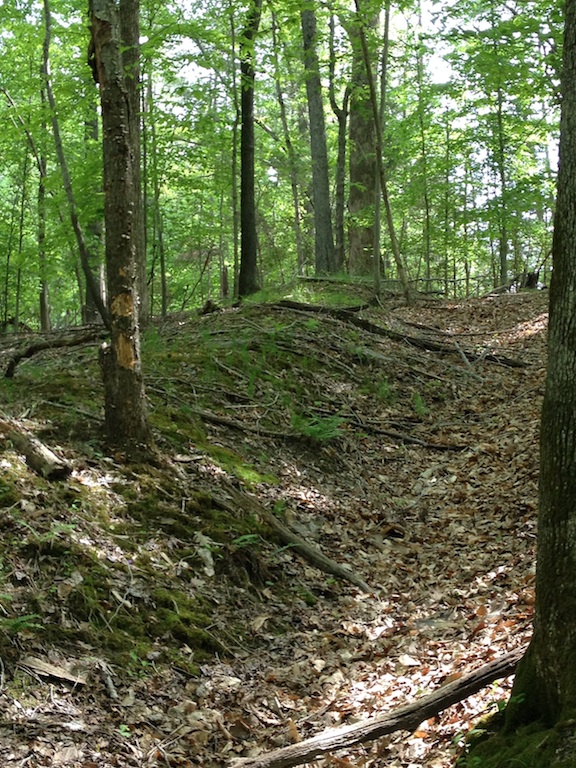My Own Spotsy Battlefield

Not many people get to own a piece of battlefield, but last month, I was fortunate enough to marry into a family that does. And it wasn’t just any battlefield—it’s the battlefield I am best acquainted with and most deeply attached to: Spotsylvania Court House.
My family’s property, Stevenson Ridge, sits adjacent to the core of the battlefield protected by the National Park Service. My father-in-law, Dan Spear, has spent his decade of ownership ensuring this portion of the battlefield likewise remains protected. It’s been my job, since joining the family, to make sense of what’s out there so we can better tell this part of the larger story.
The presence of the Union army is writ large on the landscape here. Earthworks snake through the forest in long rows. The Federal IX Corps, operating independently of but in concert with the Army of the Potomac, moved in midmorning on May 9—150 years ago today—to take up position along the Union left.

Most of the Federals had come down from the Wilderness along the Brock Road on May 8, but with that route so clogged, the IX Corps took a route that led it through the old Chancellorsville battlefield along the Old Plank Road, down country roads, and eventually to the Fredericksburg Road (modern day Rt. 208, aka Courthouse Road).
Fredericksburg Road proved to be of huge strategic importance for Federal commander Ulysses S. Grant. Capturing the road enabled him to shift his base of operations from Culpepper—more than thirty miles away along a hard-to-defend supply route—to Fredericksburg. The new supply route would be shorter, more convenient, and easier to defend. Burnside’s presence along the road proved vital.
Marching across the Ni River, the IX Corps deployed across farmland owned by the Beverly House, whose farm sat on the east side of the road. The Union line stretched westward across the road and through the fields that are now Stevenson Ridge.

It was the first time the corps had the opportunity to build field fortifications, and being away from the main action—most of which was still centered on Spindle Field to the northwest—the IX Corps men were able to build their works unimpeded by sniper fire. As a result, they built a set of textbook-perfect field fortifications—literally.
The design they followed, conceived by Maj. James St. Clare Morton, called for a log wall with dirt heaped up in front of it. The dirt came from a ditch that soldiers dug in front of the position. In theory, an approaching enemy would have to go down into the ditch and then scale the heap of dirt while Federals stood behind the safety of the log wall and fired at them the whole time.
As is often the case, theory doesn’t always hold up when put into practice, as the IX Corps quickly discovered.

Morton himself inspected the works. By that point in the war, he’d been assigned as chief engineer of the IX Corps. What he saw appalled him. He called them some of the worst works he’d ever seen—not realizing, apparently, that they followed his designs perfectly.
By that point in the war, more experienced troops had realized a significant flaw in Morton’s design. While digging the ditch in front of the mound of dirt, they were exposed to enemy fire. They quickly learned to construct their log wall and then dig their ditch behind it, throwing the dirt over the top of the wall to heap it on the far side. That way, they were protected in their work by the very fortifications they were building.
IX Corps soldiers soon learned the error of their ways, and in other places—including other places at Spotsylvania—they built their works in the more traditional way. What they left behind at Stevenson Ridge, however, serves as an outstanding and rare example of “textbook” fortifications.
I’ve spent a lot of time this spring studying Stevenson Ridge’s earthworks. I’ve had cartographers, historians, and natural resource experts walk the ground with me, and we’ve puzzled over the stories the ground has to tell. We’ve found command bunkers, covered ways that soldiers used to transport supplies to the front, and even a set of earthworks constructed when the V Corps occupied this same ground later in the battle. I’ll have more detailed information to pass along as the summer goes by, but in the meantime, it’s been a privilege to puzzle through the possibilities with some incredibly brilliant people.
The IX Corps would occupy the area for a few days before moving to a forward position a few days later. By May 13, the V Corps would move into the area for a few days. In total, the army would occupy the area until the night of May 20, when it finally slipped away toward the North Anna River.
I can only image what this landscape looked like to those soldiers when they first filed into position 150 years ago. Today, the forest was lush with rich spring green. I heard nary a sound as I walked the trails and traced the earthworks—but if I listened really hard, I could almost hear the echo of shovels and spades and axes, chopping and digging, settling in for the bloody work that surely laid ahead.


1 Response to My Own Spotsy Battlefield